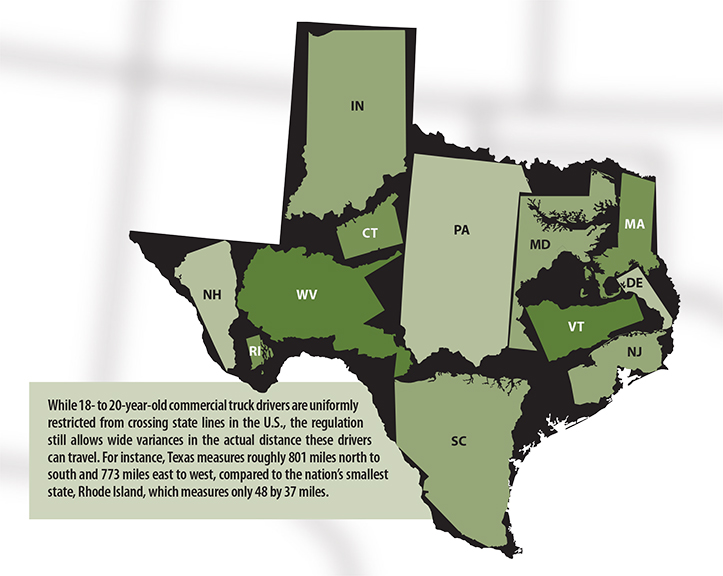In September, the Federal Motor Carrier Safety Administration (FMCSA) proposed a new pilot program that would allow commercial driver’s license (CDL) holders aged 18, 19, and 20 to operate commercial vehicles in interstate commerce. Currently, commercial drivers under the age of 21 are not allowed to cross state lines.
Drivers falling into one of the following categories would be allowed to participate in the pilot program:
- 18- to 20-year-old commercial driver’s license (CDL) holders who operate CMVs in interstate commerce while taking part in a 120-hour probationary period and a subsequent 280-hour probationary period under an apprenticeship program established by an employer; or
- 19- and 20-year-old commercial drivers who have operated CMVs in intrastate commerce for a minimum of one year and 25,000 miles. The study group drivers would not be allowed to operate vehicles hauling passengers or hazardous materials or special configuration vehicles.
Public reaction to the proposed program has been mixed. Some in the trucking industry argue that, if men and women are allowed to enlist in the military and engage in active combat at age 18, they should also be allowed to drive a truck across state lines. Others oppose the notion, citing the possibility of increased insurance premiums or expressing concern about allowing younger, less experienced drivers to take on long, grueling routes.
Truckload Carriers Association Vice President of Government Affairs David Heller said he believes the program is an important step toward gathering the information needed to determine whether younger drivers should, in fact, operate across state lines. In addition, he noted, TCA planned to submit comments in support of the proposed program.
“The reality is, younger drivers of this age demographic are already operating in our industry today, albeit in an environment that prohibits them from crossing state lines and solely driving freight that classifies as intrastate commerce,” he noted. “The proposed pilot program represents a tremendous opportunity to collect safety-performance data that doesn’t (currently) exist, and determine whether or not the drivers in question can perform at a level that is as safe or safer than their more seasoned counterparts.”
The public comment period for the FMCSA’s proposed program was to end November 2, 2020. This new “under-21” pilot program would complement a similar program, announced in July 2018, that allows 18- to 20-year-olds who have received qualifying military training in the operation of heavy-duty vehicles to engage in interstate commerce. Currently, seven military specialties qualify for the program. On October 9, 2020, the FMCSA posted a notice in the Federal Register that proposes adding an additional eight specialties; the comment period for this proposal ends November 9, 2020.
A number of carriers offer in-house driver training and apprenticeship programs to ensure new hires are prepared to take on the challenges of the road. Ohio-based Garner Trucking Inc. and Maryland-based D.M. Bowman Inc. are two such companies. In addition, both companies participate in the FMCSA’s under-21 military driver program.
“I think this is fantastic,” said Garner Trucking Inc. President, CEO, and Owner Sherri Garner Brumbaugh. “We will finally have the opportunity to introduce more young people to our industry. Garner is an approved carrier for the military younger driver pilot program, and I welcome the addition of non-military drivers.”
D.M. Bowman Inc. President Jim Ward agreed that the new pilot program could be a plus for the industry, adding that modern trucks are often equipped with technology to help drivers adapt to driving a big rig.
“Truly, with the safety technology on today’s equipment, it’s much different than it was, I’d say probably even five years ago, in regard to training these individuals,” Ward said. “It sets the stage for young people to operate the equipment, I believe, in a very safe and efficient manner.”
Another aspect to consider is the size of the state when deciding whether to allow less experienced drivers to cross state lines, noted Ward.
“Where we live here in Maryland, Interstate 81 is 12 miles long — that’s from the West Virginia line to the Pennsylvania line,” he explained. “So, an intrastate driver can drive all the way across the state of Texas, but we can’t drive from Maryland down to West Virginia, or from Maryland up to Chambersburg, Pennsylvania, neither route involving heavy traffic, because the intrastate driver can’t cross that state line.”
For comparison, Texas extends about 801 miles north to south and 773 miles east to west, while Maryland measures about 250 miles long by 90 miles wide.
Brooke Estes, a driver-trainer for D.M. Bowman, weighed in on the issue, noting that ultimately, the decision of whether a driver is ready for interstate travel should be taken on a case-by-case basis. He also said that interstate drivers must be prepared to interact with more customers and the general public more often than those traveling regional day routes.
“I’ve had very positive experiences with younger drivers,” he said, pointing out his current trainee, who is 21. “They’re very enthusiastic. They soak in the information and the skills that we’re trying to instill in them.”
Regarding the amount of training required to prepare a driver for interstate travel, regardless of the driver’s age, Estes said, “It depends on the person. If they need more training, we don’t just release them and let them go out there. We will extend their training if we need to.”
Brumbaugh said she would be comfortable allowing 18- to 20-year-olds to drive interstate routes after successfully completing training through her company, adding that they require additional training time for younger drivers. In addition, she said, drivers under 21 would be governed at a lower speed than their more experienced counterparts.
“I am comfortable with a younger driver on interstate routes because of the additional training they will receive, the additional safety technologies on their trucks, and the additional monitoring they will have,” she stated. “These will far exceed their elder counterparts.”
Linda Garner-Bunch has been with The Trucker since 2020, picking up the reins as managing editor in 2022. Linda has nearly 40 years of experience in the publishing industry, covering topics from the trucking and automotive industry to employment, real estate, home decor, crafts, cooking, weddings, high school sports — you name it, she’s written about it. She is also an experienced photographer, designer and copy editor who has a heartfelt love for the trucking industry, from the driver’s seat to the C-suite.















